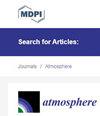美国西南部的颗粒物质:利用地表测量和地基激光雷达探测和分析沙尘暴
IF 2.5
4区 地球科学
Q3 ENVIRONMENTAL SCIENCES
引用次数: 0
摘要
这项研究的重点是颗粒物质与行星边界层之间的耦合。颗粒物影响人类健康,它是一种复杂的悬浮物质混合物。颗粒物的来源多种多样,包括火山爆发、强风掀起的泥土、野火以及气相排放物化学反应形成的颗粒物。强风卷起土壤颗粒时,是尘埃污染的一个来源。颗粒物质与行星边界层密切相关。由于行星边界层参与能量、潜热和质量与自由对流层的传递,因此在气象学和颗粒物浓度方面发挥着至关重要的作用。德克萨斯州埃尔帕索位于西半球最大的沙尘源之一--奇瓦瓦沙漠,目前还没有关于沙尘事件对该地区行星边界层影响的研究。在这项研究中,我们使用 PM10 浓度来检测埃尔帕索地区 2016-2022 年期间的沙尘事件。在研究期间,我们观测到 74 次沙尘事件。这些沙尘事件被分为同步和对流两种情况。同步事件与冷锋有关,而对流事件则与雷暴等局地对流系统有关。我们观察到,同步沙尘暴多发生在春季,而对流沙尘暴则多发生在夏季季风季节。同步天气往往发生在下午较早的时候,气温较低,而对流天气往往发生在傍晚,气温较高。我们还发现,在 PM10 浓度达到每小时最大值后,行星边界层高度会坍塌,然后边界层会恢复到原来的高度。本文章由计算机程序翻译,如有差异,请以英文原文为准。
Particulate Matter in the American Southwest: Detection and Analysis of Dust Storms Using Surface Measurements and Ground-Based LIDAR
This research study focuses on the coupling between particulate matter and the planetary boundary layer. Particulate matter affects human health and it is a complex mixture of suspended substances. Various sources of particulate matter include volcanic eruptions, soil lofted by strong winds, wildfires, and particles formed from chemical reactions of gas-phase emissions. Strong winds are one source of dust pollution when they loft soil particles. Particulate matter and the planetary boundary layer are closely linked. The planetary boundary layer plays a critical role in meteorology and particulate matter concentrations due to its involvement in energy, latent heat, and mass transfer with the free troposphere. Currently, there has been no research on the impact of dust events on the planetary boundary layer in our region, El Paso, Texas, which is located on one of the biggest sources of dust in the Western Hemisphere, the Chihuahuan Desert. In this study, we used PM10 concentrations to detect dust events during the 2016–2022 period in the El Paso region. During the study period, we observed 74 dust events. The dust events were categorized as synoptic or convective cases. Synoptic cases are associated with cold fronts, while convective cases are associated with local convective systems such as thunderstorms. We observed that synoptic cases occurred most frequently during springtime, while convective cases were more frequent during summer monsoon months. Synoptic cases tend to occur earlier in the afternoon with lower temperatures, while convective cases tend to occur in the late evening with higher temperatures. We also found that the planetary boundary layer height collapsed after the maximum hourly PM10 concentration and then the boundary layer returned to its original height.
求助全文
通过发布文献求助,成功后即可免费获取论文全文。
去求助
来源期刊

Atmosphere
METEOROLOGY & ATMOSPHERIC SCIENCES-
CiteScore
4.60
自引率
13.80%
发文量
1769
审稿时长
1 months
期刊介绍:
Atmosphere (ISSN 2073-4433) is an international and cross-disciplinary scholarly journal of scientific studies related to the atmosphere. It publishes reviews, regular research papers, communications and short notes, and there is no restriction on the length of the papers. Our aim is to encourage scientists to publish their experimental and theoretical research in as much detail as possible. Full experimental and/or methodical details must be provided for research articles.
 求助内容:
求助内容: 应助结果提醒方式:
应助结果提醒方式:


